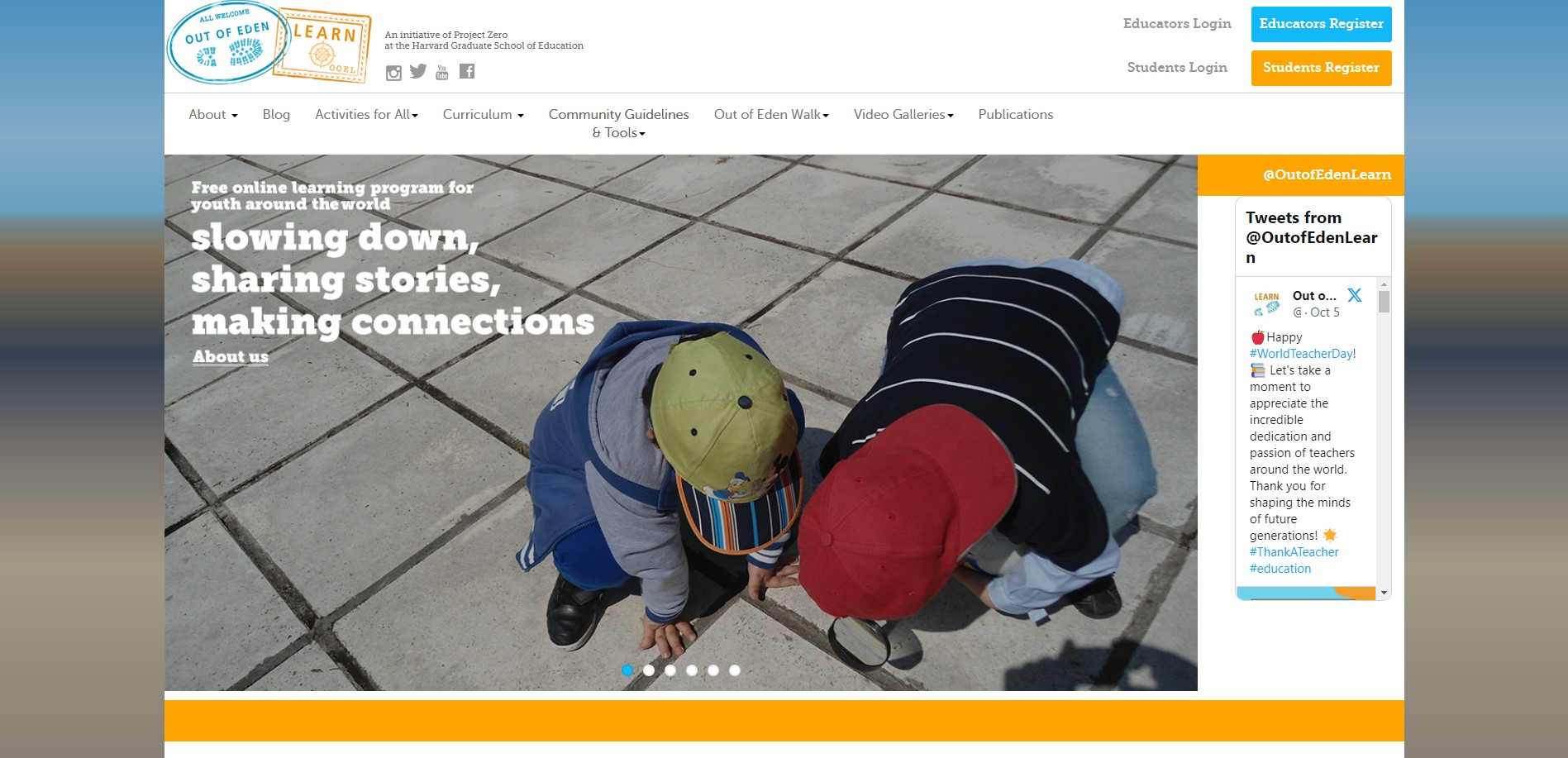Out of Eden Learning Tool
When looking for a learning tool, I first had to decide which grade band I would be most interested in. I chose to look in the “Resources for Global Education for 9-12” because I believe that age group allows for more discussions and more thought out ideas about topics. While scrolling through the list of tools, I ended up choosing “Out of Eden Learning.”

I chose this because of the description that I read. It really caught my attention. It first mentions that it is “an initiative of Project Zero at the Harvard Graduate School of Education.” Personally, and I would imagine many others, when I see anything related to Harvard I instantly assume that it must be a great resource. That is just down to the reputation that Harvard University has.
It also explained that it is completely free to use and it is an online program. As we have seen over the past decade, technology has been used more and more in classrooms all over the country and world. This trend will only continue, which is a great thing. We must work along with it. Younger students are also having more access to devices at home and in school. Many of them may even prefer it. Out of Eden is a “custom built, social media platform,” which only adds to why it is best for students around this age range. Social media is heavily targeted at this group of individuals, so they may feel more comfortable using this tool and website in the classroom.
The description also included a little bit about the tool’s credentials. Out of Eden has “so far served over 30,000 students in 60 countries.” That is just amazing. It must be something great for that many students to have used it, but not only that, it is used all over the world. That is what stood out most to me from that statement. The internet is a space that is meant to allow people all over the planet to work together and most importantly, learn from each other.
Actually getting to the website, it has a very friendly interface, and it is easy on the eyes. It does not feel clunky and the images on the homepage move smoothly. It does not jump from picture to picture, it fades into the next one. That is so important when using an online program. I do not want to use a program that is tough to navigate, feels slow loading, or ugly. Everything that I mentioned from the description and the look and feel of the website really made me choose Out of Eden Learning.

As stated before, Out of Eden is an initiative of Project Zero. In their about section of their website, Project Zero claims their mission is to understand and nurture human potentials like learning, thinking, and creativity. In the “About Us” of Out of Eden, they list three learning goals from their program.

I believe this would be useful for students to really understand different cultures around the world and to have them pay closer attention to the world around them.
Towards the top of the website, there are different tabs for different areas. The two most useful to me and a future classroom are the “Curriculum” and “Activities for All” tabs.
When looking through the curriculums, the “Introduction to Planetary Health” is the one that I would include in my classroom. The topic about planetary health always stands out to me. Their 4 steps for the project look like something students could really have fun doing.

This really gives students a chance to just simply go out and look at their surroundings. They may find something that can affect the health of themselves and others in their area. In doing the other steps, they will do their own research and investigation about an issue of their choosing and try to make a difference. It is all about making small changes that could lead to something bigger.
The “Activities for All” sections gives a list of activities for the curriculums you could choose from, which is a great thing for educators. From their list, I do not see one that would fit in with the curriculum that I chose, but that is not an issue. The steps, pictured above, would give the students more than enough to do.
The last things that is useful, and definitely a necessity, is the login/register for both educators and students. This will help organize the different activities of students in my classroom. Out of Eden also recommends getting in contact with other classrooms, so both classes can meet each other and feel more involved. Collaboration is always a great thing. Out of Eden really sets you up with all the tools you need.
Mapping the Nation Tool
One of the best ways you can get kids more engaged in learning is by providing them with tools with which they can learn and have fun simultaneously.
Combining technology with learning can make for very interesting ideas on how to gain knowledge while also learning how to use technology.
A great tool I found for K–8 students is this interactive map by Asia Society that pulls together demographic, economic, and education indicators into data points that students can use to learn about the world.
This tool can increase the students knowledge about other parts of the world they might not be aware of.
They can figure out these stats through an interactive map:

The maps are color-coded, so it is easier for people to notice the differences and statistics.
This tool can be great for kids to learn and explore the world.
Students can learn about interesting statistics like the total population of areas, the number of languages spoken in each area, and the ancestry of the people living there. This tool can inform students about stats they never knew and provide a visual for them.
It is very important for kids to learn about the world they are living in, and these interesting statistics make them more informed about their country and the demographics that make it up.
If I were a teacher, I would let kids explore this tool and ask each other questions about the statistics and demographics. This would improve their ability to read and relay information to others.
Navigating Collaboration in the Classroom
Education is an essential part of being a contributing member of society and navigating one’s personal life. When thinking about school the basics come to mind: social studies, math, english, and science, but there is a myriad of things learned in the classroom that is not explicitly stated in lesson plans. For many people, the time spent in a classroom is the first experience interacting with people outside of immediate family. Students accidentally learn how to navigate social and professional situations. Adding an element of student collaboration to the classroom assists in developing these skills, but can be tricky to successfully implement in a beneficial way.
Deeper Learning: A Collaborative Classroom Is Key : Please visit this link for more information regarding how to build a collaborative environment that is beneficial to learning.
The above linked article, written by Rebecca Alber, discusses not only the importance of students working together but how to ensure those students are benefiting from working together. One such technique that I want to highlight is the idea of modelling. Children begin modelling those around them at an early age and in many ways can become a product of their environment. If, as a teacher, you wish to see students engage with each other in a positive way that is conducive to learning – you have to do more than assign group work, you have to demonstrate for them how.

Important things to model for students, summarized:
- Listening: If you wish for students to learn from the insights of other students in the room, they have to know the difference between listening and hearing. This can be shown by actively engaging with students yourself when speaking with them, such as paraphrasing they say back to them to ensure that it was understood correctly.
- Constructive Questioning: When working with others, there will inherently be the presence of differing opinions showing students how to questions these differences in a way that builds on the information will product a more positive outcome.
- Negotiating: Kids are not always going to agree on the way to approach a topic, teaching students how to respectfully negotiate with each other help ensure that everyone is able to present and defend their position. This will also lead to a project where everyone’s voice is present.

Naturally, there will be issues that arise in group class work but I do believe that modelling the correct behavior when working with others as a standard in your classroom will negate a majority.
Students Connecting Around the World
Of the Global Educator Toolkit, I found Empatico’s concept especially interesting. This organization promotes empathy between students, from near and far. Through virtual meetings and chatrooms, children are able to interact with others from all around the world! I would incorporate this concept into my own classroom through the use of pen pals. This website would be very helpful in getting pen pals started in the classroom. Pen pals allows students to write back and forth with another student from a different country, which ultimately promotes positive diversity. I highly value the importance of children being aware of what life is like in countries around the world, keeping an open mind!

Empatico is great for students of all ages, making connections is key in shaping a child’s education, but international connections promotes empathy and diversity!